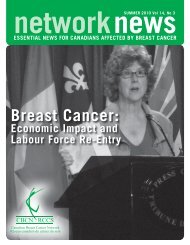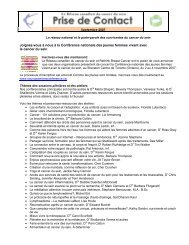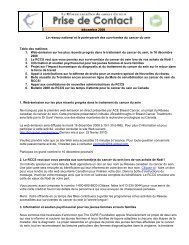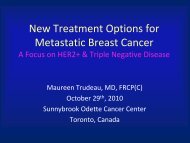Network News - Winter/Spring 2010 - Canadian Breast Cancer ...
Network News - Winter/Spring 2010 - Canadian Breast Cancer ...
Network News - Winter/Spring 2010 - Canadian Breast Cancer ...
Create successful ePaper yourself
Turn your PDF publications into a flip-book with our unique Google optimized e-Paper software.
What is BRCA?<br />
By Dawna M. Gilchrist, MD, FRCPC, FCCMG, DHMSA<br />
What are BRCA1 and BRCA2?<br />
BRCA1 and BRCA2 are human genes<br />
that belong to a class of genes known as<br />
tumor suppressors.<br />
In normal cells, BRCA1 and BRCA2<br />
help ensure the stability of the cell’s<br />
genetic material (DNA) and help<br />
prevent uncontrolled cell growth.<br />
Mutation of these genes has been<br />
linked to the development of<br />
hereditary breast and ovarian cancer.<br />
The names BRCA1 and BRCA2 stand<br />
for breast cancer susceptibility gene 1<br />
and breast cancer susceptibility gene 2,<br />
respectively.<br />
In the general population,<br />
approximately 1 in 8 women (12%)<br />
will develop breast cancer and 1.5-2%<br />
will develop ovarian cancer in her<br />
lifetime. Only 5-10% of breast and<br />
ovarian cancer is hereditary, that is,<br />
due to mutations in specific cancer<br />
susceptibility genes.<br />
How do people know if they should<br />
consider genetic counselling for<br />
BRCA1 and BRCA2 mutations?<br />
The likelihood of a harmful mutation<br />
in BRCA1 or BRCA2 is increased with<br />
certain familial patterns of cancer.<br />
These patterns include the following:<br />
For women of Ashkenazi Jewish descent:<br />
• Any first-degree relative<br />
diagnosed with breast or ovarian<br />
cancer and<br />
• Two second-degree relatives on the<br />
same side of the family diagnosed<br />
with breast or ovarian cancer<br />
These family history patterns apply<br />
to about 2% of adult women in the<br />
general population. Women who have<br />
none of these family history patterns<br />
have a low probability of having a<br />
harmful BRCA1 or BRCA2 mutation.<br />
In a family with a history of breast<br />
and/or ovarian cancer, it may be most<br />
informative to first test a family member<br />
who has breast or ovarian cancer. If<br />
that person is found to have a harmful<br />
BRCA1 or BRCA2 mutation, then other<br />
family members can be tested to see if<br />
they also have the mutation.<br />
Regardless, women who have a<br />
relative with a harmful BRCA1 or<br />
BRCA2 mutation and women who<br />
appear to be at increased risk of breast<br />
and/or ovarian cancer because of their<br />
family history should consider genetic<br />
counselling to learn more about their<br />
potential risks and about BRCA1 and<br />
BRCA2 genetic tests.<br />
BRCA1<br />
Women with BRCA1 mutations have,<br />
by age 70, an average cumulative<br />
breast cancer risk of approximately<br />
57% (47%-66%). Approximately half<br />
develop breast cancer by the age of<br />
50. By age 70, there is an average<br />
cumulative ovarian cancer risk of<br />
approximately 40% (35%-46%), and<br />
this risk starts to significantly increase<br />
in the 30’s.<br />
Risk for Manifesting <strong>Breast</strong> <strong>Cancer</strong><br />
per Decade:<br />
Age %<br />
20-30 3.6<br />
30-40 14.0<br />
40-50 31.0<br />
50-60 15.0<br />
60-70 7.0<br />
Men with BRCA1 mutations are only<br />
at a slightly increased lifetime risk for<br />
prostate cancer and breast cancer.<br />
BRCA2<br />
Dr. Dawna M. Gilchrist<br />
Women with BRCA2 mutations have,<br />
by age 70, an average cumulative<br />
breast cancer risk of approximately<br />
49% (40%-57%). Approximately one<br />
in three women will develop breast<br />
cancer by age 50. By age 70, there is an<br />
average cumulative ovarian cancer risk<br />
of approximately 18% (13%-23%), and<br />
this risk starts to significantly increase<br />
in the 40’s.<br />
Risk for Manifesting <strong>Breast</strong> <strong>Cancer</strong><br />
per Decade:<br />
Age %<br />
20-30 0.6<br />
30-40 12.0<br />
40-50 36.0<br />
50-60 20.0<br />
60-70 36.0<br />
Men with BRCA2 mutations are at<br />
a three times increased lifetime risk<br />
for prostate cancer (compared to<br />
12% in the general population). The<br />
lifetime risk for male breast cancer is<br />
approximately 6%.<br />
Risk of a Second Primary<br />
<strong>Breast</strong> <strong>Cancer</strong><br />
The risk for another primary breast<br />
cancer is up to five times higher with<br />
a BRCA1/2 mutation (as compared to<br />
sporadic breast cancer), with a lifetime<br />
risk of 40-50% by age 70. The risk for a<br />
second primary breast cancer may be<br />
reduced by previous treatment with<br />
Tamoxifen and/or previous treatment<br />
with chemotherapy that produces<br />
menopause.<br />
<strong>Network</strong> <strong>News</strong> <strong>Winter</strong>/<strong>Spring</strong> <strong>2010</strong> 11














